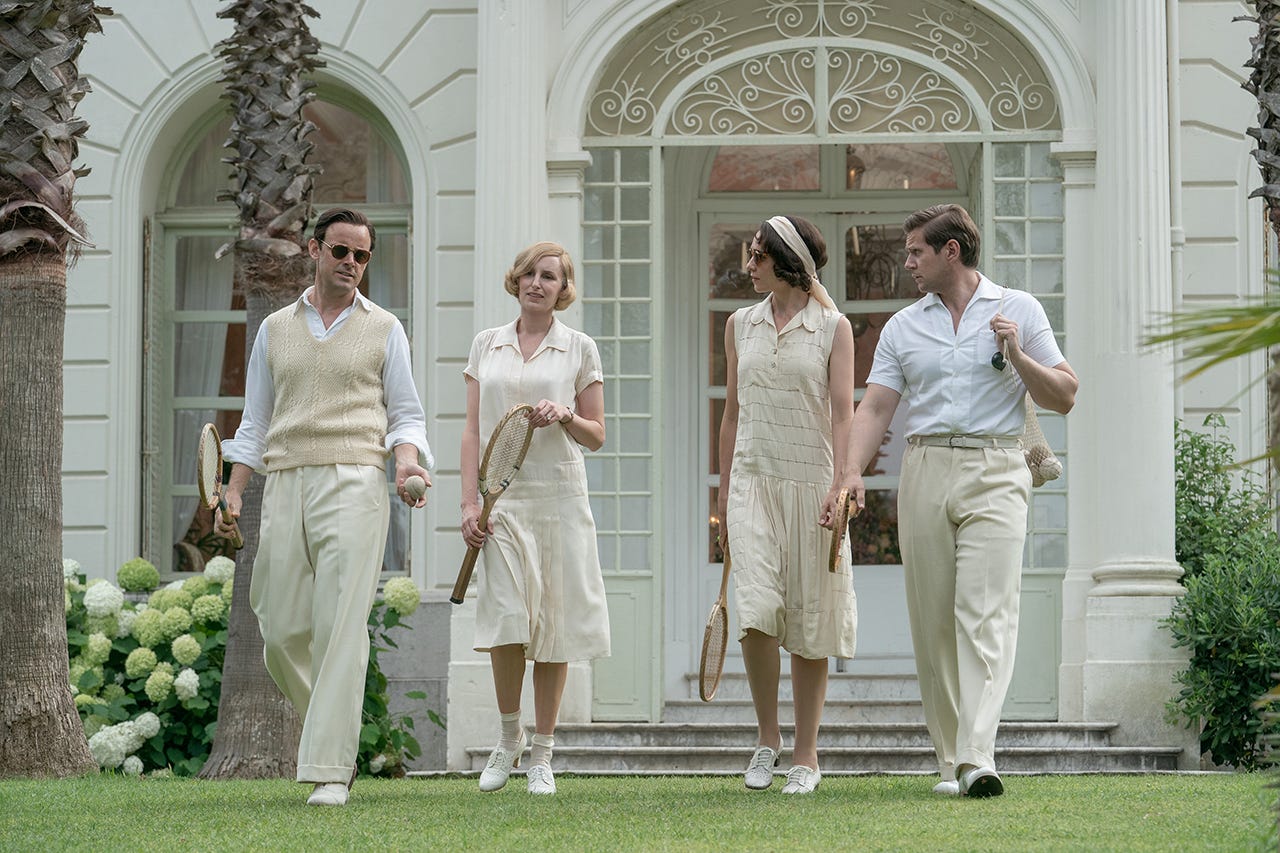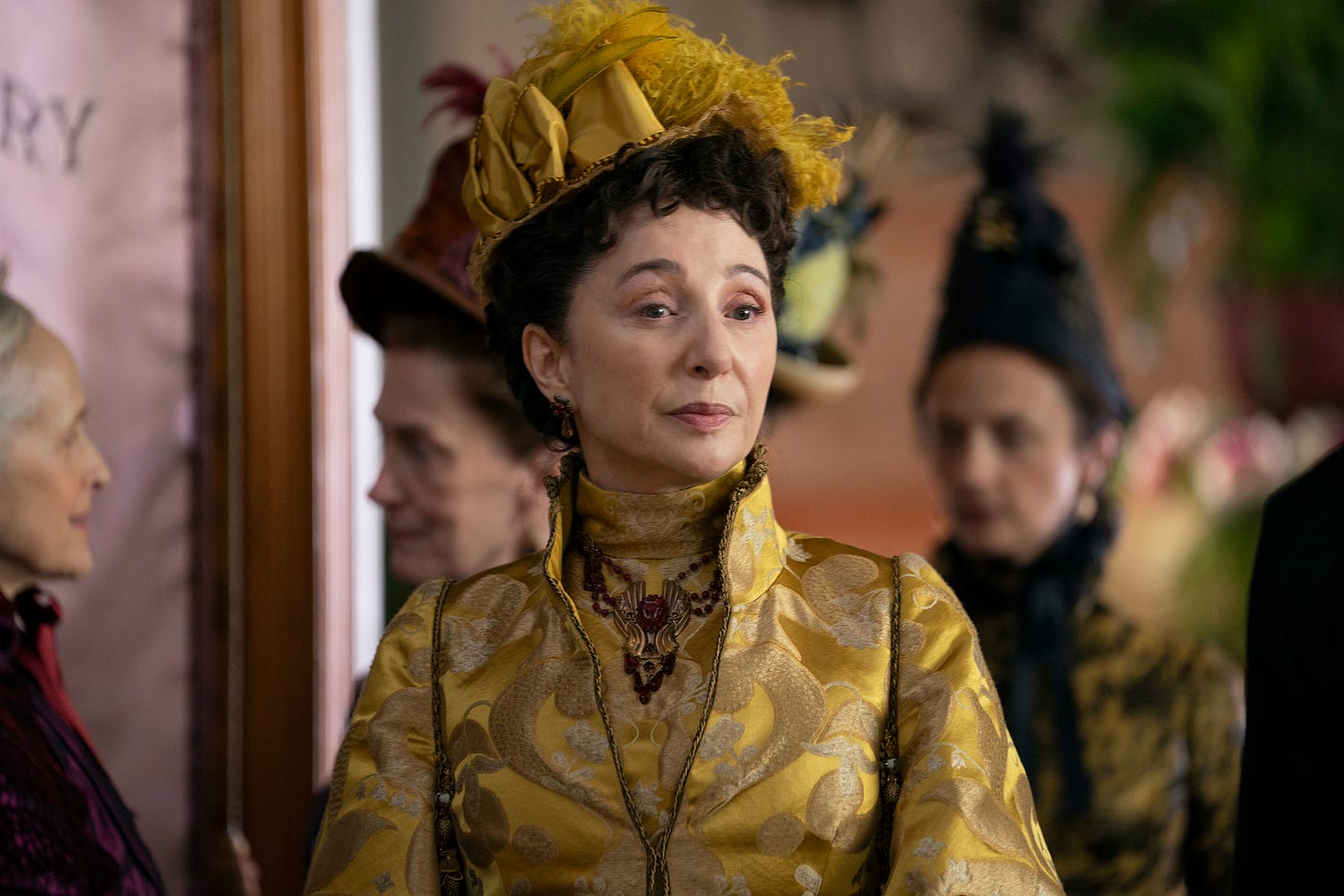Outtake No. 7: 'The Gilded Age' Syllabus
Your guide to Julian Fellowes' latest historical drama.
“Outtakes” is back with another installment about all things pop culture. This week, the focus is on Julian Fellowes’ anticipated costume drama, The Gilded Age, which premieres Monday, Jan. 24 on HBO and HBO Max.
Like I did for HBO’s other hits, Watchmen and Lovecraft Country, I put together a quick guide to a number of historical and pop culture references that are worth remembering while watching…
In similar fashion to the creator’s predecessors, Downton Abbey and Belgravia, the HBO series is a sweeping, star-studded period piece about class and society. But this time, it’s set in the 1880s in New York City during the period of great economic change in America, with Christine Baranski, Cynthia Nixon and Carrie Coon leading the sprawling ensemble.
The series kicks off with the arrival of newcomer Marian Brook (Louisa Jacobson), who comes to New York City to stay with her wealthy aunts, the snarky Agnes van Rhijn (Baranski), who echoes Maggie Smith’s Dowager, and her sister, Ada Brook (Nixon). At the same time, the self-made railroad tycoon George Russell (Morgan Spector) and his ambitious wife Berth (Coon), make a statement of their own by moving in across the street and ignite a class war between old money and new money.
Rounding out the main cast is Denée Benton as aspiring writer Peggy Scott, Thomas Cocquerel as the young lawyer Tom Raikes, Taissa Farmiga as the Russell’s desperately single daughter Gladys, Jack Gilpin as the Russell family’s butler Church, Simon Jones as Rhijns' butler Bannister, Harry Richardson as the Russell’s self-assured son Larry, and Blake Ritson as Rhijn's son and eternal bachelor Oscar.
American Dynasties
As Fellowes explained to ET, the series itself was inspired by the stories he read about new American dynasties at the time, led by Andrew Carnegie, J.P. Morgan and Cornelius Vanderbilt, and the way these families shrewdly created their own society. “They made a new way of being rich,” he said. “It wasn’t borrowed from Europe, which had been the way before the Civil War.” Suddenly things were more about “huge consumption: palaces down Fifth Avenue, palaces in Newport, carriage races, yachts bigger than anything that anyone had ever seen.”
Authors Edith Wharton and James Henry
It’s hard to ignore the influence both renowned authors have on Fellowes’ latest creation. Not only is the setting, the time and even the central ingenue all similar to what both wrote about in novels, like The Age of Innocence and The Portrait of a Lady, but New York Times television critic Mike Hale points out the unavoidable comparisons:
A scene set at the Academy of Music, once New York’s primary opera house, directly invokes Wharton’s “The Age of Innocence”; a scene in which a mercenary suitor is sent packing is straight out of James’s “Washington Square” and its theatrical adaptation, Ruth and Augustus Goetz’s “The Heiress.”
Belgravia and Downton Abbey
First premiering in the U.S. in 2011 on PBS (with introductions by Laura Linney), Downton Abbey quickly became a cultural phenomenon. Over the course of six seasons, audiences followed the drama, romance and scandals of the lives living at the Yorkshire country estate in the early 1900s.
Upstairs was the aristocratic Crawley family led by Robert (Hugh Bonneville), Earl of Grantham, who was married to Cora (Elizabeth McGovern) and had three daughters, Sybil (Jessica Brown Findlay), Edith (Laura Carmichael) and the often troublesome Mary (Michelle Dockery). They were often joined by the quibbling Dowager Countess of Grantham and cousin Isobel (Penelope Wilton). Meanwhile, the downstairs was full of its own intrigue thanks to an expansive staff run by Mr. Carson (Jim Carter) and Mrs. Hughes (Phyllis Logan).
The franchise, which has spawned two film sequels, was followed by the 2020 EPIX limited series, Belgravia, about the aspirations, lies and affairs of interwoven families living in the affluent district of London during the mid-1800s. While darker than its predecessor, the series explored how class structure dictates and affects the daily lives of these families. It featured an ensemble cast led by Tamsin Greig, Harriet Walter, Tom Wilkinson and Alice Eve.
The Gilded Age, meanwhile, is set between those two series and is the unofficial link between these sprawling universes about money, class and society. However, don’t expect to see Lily Adams reprise her Downton Abbey role as Lady Rose MacClare, the fast and loose cousin who briefly stayed with the Crawleys during seasons 4 and 5 before moving to New York City with her husband sometime between 1924 and 1925. Though, a much older Marian Brook (Louisa Jacobson) could later encounter her at some high society function—in my soon-to-be-written fan fiction uniting both TV universes.
Broadway Cameos
Also making appearances throughout the season are legends of stage, including Michael Cerveris, Linda Emond, Katie Finneran, Michel Gill, Bill Irwin, Nathan Lane, Audra McDonald, Debra Monk, Donna Murphy, Kelli O’Hara and Jeanne Tripplehorn.
Because much of the series was filmed during the pandemic, when Broadway was shut down, Fellowes said they were able to take advantage of the wealth of actors out of work. “That really came originally from [director] Michael Engler… And he said, ‘Look, you do realize that all theaters are dark. And we’ve got some of the great talents in the country. And they’re all home watching daytime television. So, let’s get them,’” the creator recalled, adding that everyone in the cast was “so happy to do it and so pleased to come on board.”
Sonja Warfield, who co-wrote the HBO series with Fellowes, said, “I was in awe of the talent… It was fantastic. And Julian’s right, we were the winners in all of that.”
Gay New York: Gender, Urban Culture, and the Making of the Gay Male World, 1890-1940
Unlike Thomas Barrow (Robert James-Collier), who had to wait six seasons and a movie before he finally got a proper, gay romance on Downton Abbey, The Gilded Age wastes no time in showing one of its leads, Oscar van Rhijn, in bed with his partner, played by Company breakout Claybourne Elder.
While the two are closeted here, the characters are given a far more complex dynamic that is surprisingly aligned with the times, as documented in George Chauncey’s 1994 nonfiction account of gay life, which says there was a far more open gay culture than one would suspect.
Historical Figures Caroline Astor, Clara Barton, T. Thomas Fortune and Ward McAllister
Like any good historical drama, the series features a few cameos and supporting roles that are comprised of real-life figures. Among those featured in The Gilded Age are heiress and socialite Caroline Astor (Amy Forsyth) and her mother, Mrs. Astor (Murphy), “the undisputed head of New York society.”
Someone caught up in the social climbing is American Red Cross founder Clara Barton (Emond), who welcomes Bertha’s charitable donations much to the chagrin of others, and the era’s ultimate arbiter of rules and taste, Ward McAllister (Lane).
Meanwhile, Sullivan Jones portrays civil rights leader and journalist T. Thomas Fortune, who became editor and owner of the Freeman, one of the most prominent Black newspapers at the time.
Jesse James
American outlaw, robber and guerrilla leader, the pursuit of Jesse James was quite the media sensation in the 1880s, even capturing the attention of New York society, before his crime spree coming to an end in 1882, when he was shot and killed by Robert Ford.
While there have been many onscreen depictions of James, including Brad Pitt in The Assassination of Jesse James by the Coward Robert Ford, somehow he never appeared on David Milch’s HBO series, Deadwood, which is also set in the late 1800s. And that is a real shame because it would have been fun to see Fellowes’ and Milch’s universes overlap.
J.P. Morgan
While not featured onscreen, the successful American banker and the great-grandfather of Real Housewives of New York City star Sonja Morgan’s ex-husband, gets a shoutout on The Gilded Age.
And given the series’ focus on old money versus new money, it’s only fitting that Lady Morgan is somehow connected, especially given her obsession with John Adams Morgan’s family name. The same one, whose legacy she famously protected on the Bravo reality series, when she told her co-stars, “You don’t touch the fucking Morgan letters,” after a visit to the Ventfort Hall Mansion and Gilded Age Museum.
Panama Canal
Apparently, some people weren’t impressed with the waterway connecting the Atlantic and Pacific Oceans and engineering feat first built in 1881.
Robber Barons
The term, first coined by The Atlantic Monthly, refers to American businessmen who rose to power during the 19th century by using unethical or illegal practices to expand their wealth.
Most importantly, what I remember most about Robber Barons is the octopus cartoon that appeared in a number of my history texts books growing up.
Here, the term applies to the deliciously ruthless railroad tycoon George Russell, who, alongside with his ambitious wife Bertha, “attack the enemy from both sides.”
Six Degrees of Meryl Streep
Louisa Jacobson: Steep’s other, other daughter behind Mamie and Grace Gummer makes her debut as Marian Book, the young newcomer to New York City’s high society.
Christine Baranski: The longtime actress previously appeared in both Mamma Mia films and Into the Woods with Streep while Mamie has made multiple appearances as a lawyer on Baranski’s other series, The Good Wife and The Good Fight.
Audra McDonald: The Broadway legend co-starred in the 2015 Streep film, Ricki and the Flash. (Also, never forget when Baranski, McDonald and Streep performed “The Ladies Who Lunch” during Take Me to the World: A Sondheim 90th Birthday Celebration.)
Carrie Coon: The actress portrayed D.C. insider and editor Meg Greenfield in the 2017 ensemble film, The Post, led by Streep as publisher Katharine Graham.
Linda Emond: Who could forget the theater star’s turn as French cookbook author Simone Beck opposite Streep in Nora Ephron’s 2009 biopic, Julie & Julia?
Nathan Lane: Surprisingly, the two stars have only crossed paths once onscreen in 1987’s Ironweed.
Quick Takes
Here are a few other stories worth checking out:
‘Scream’ Star Jasmin Savoy Brown on Playing the Film Franchise's First Queer Character
‘Peacemaker’: John Cena and James Gunn on Stripping Down the Antihero for HBO Max
Sophie Thatcher Talks ‘Yellowjackets’ Finale and Joining ‘Book of Boba Fett’
‘Euphoria’ Stars Zendaya, Hunter Schafer and More Preview a Complex and Chaotic Season 2










Thank you for this comprehensive guide!